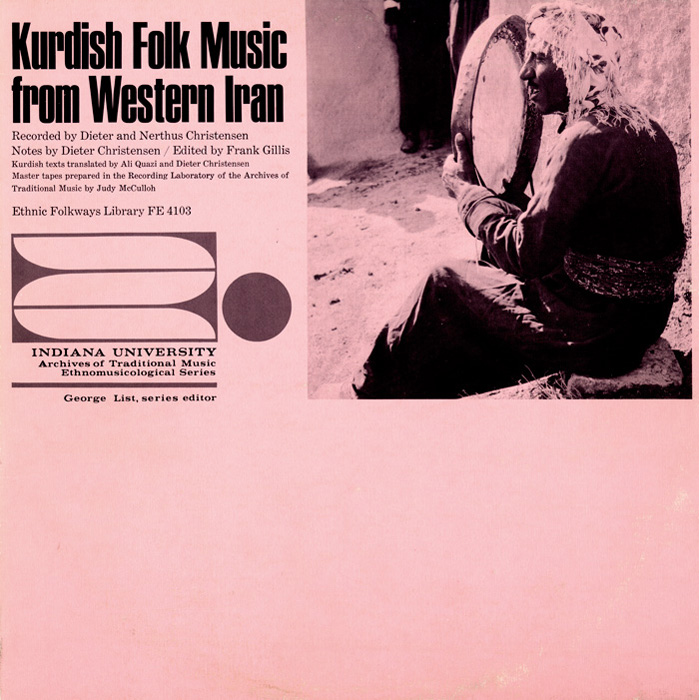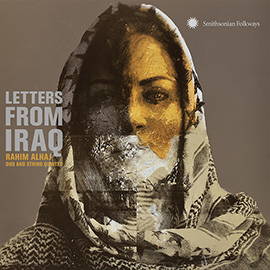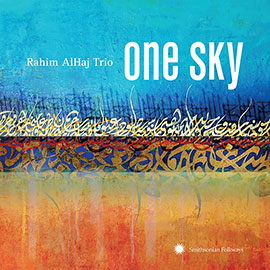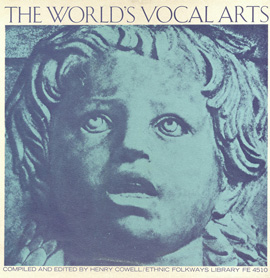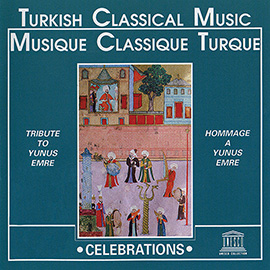Summary
“All Around This World,” a world music program for small children and their families. The lesson will introduce children and their teachers to the Kurdish people and their history and culture by leading them on a Kurdish experience full of singing and dancing.
Suggested Grade Levels: K-2
Country: Iraq, Iran, Syria, Turkey
Region: Kurdistan
Culture Group: Kurdish
Genre: Work songs, love songs, tribal dance
Instruments: Voice, hand claps, oud and doumbek introduced in video
Language: Kurdish
Co-Curricular Areas: History, Political Science/International Studies, Current Events
National Standards: 1, 3, 6, 7, 8, 9
Prerequisites: None
Objectives:
- Learn very basic concepts about Kurdish history and Kurdish rural culture (National Standard 9 )
- Sing Kurdish songs using arrangements reinterpreted with English lyrics (National Standard 1)
- Dance in the style of a Kurdish folk tradition (National Standard 8)
- “Compose”/improvise lyrics to songs in the style of Kurdish work songs (National Standard 3)
- Listen to Kurdish folk music and Middle Eastern oud music (National Standard 6, 7)
Material:
- World map or globe
- Blank paper/marker/tape
- “Kurdish Folk Music from Western Iran”
- “Kurdish Folk Songs and Dances”
- “When the Soul is Settled: Music of Iraq”
- “Video of Rahim Alhaj”
Lesson Segments:
- “The Kurds: Apart but Together”: Introduce Kurds' history of being one people divided among nations (National Standards 1, 9)
- “Good Morning, Kurdistan!”: Introduce Kurdish work song (National Standards 1, 3, 9)
- “Look in My Eyes”: Introduce Kurdish dance, in line and in unison (National Standard 1)
- “Sing To Me, Mamiana”: Introduce Kurdish love song (National Standards 1)
- “Good Night, Kurdistan!”: Introduce Kurdish lullaby (National Standards 1)
- “The Oud Dude”: Match original tracks to songs learned in previous lessons, introduce West Asian/Middle Eastern instruments (National Standards 6, 7)
Note to teachers: Ideally you will teach this lesson as part of a broader exploration of the Kurdish people, including historical and cultural information from books and the internet, classroom projects to make Kurdish art, even attempts to learn Kurdish dance. The lesson segments themselves are short and can occur one after the other in a morning of class, spread out over the course of a day or even over the course of a week. For best reinforcement, the songs learned in this lesson should become part of the classroom's “canon”-- the songs you sing throughout the school year. Also, please print copies this lesson plan and send one home with each child so their parents can join in the fun.
Lesson Segment #1: “The Kurds: Apart but Together”
Procedure:
1. Introduce the concept of “visiting” with a group of people who live far away by learning about them, singing their songs, experiencing their dances and envisioning their daily lives.
2. Show children the world map or globe and locate the area known to some as “Kurdistan,” part of which is found within the national borders of present day Turkey, Syria, Iraq and Iran. (Note: map below).

3. Move chairs and tables aside and have children stand together in the middle of the room.
4. Explain that there are 30 million people who self-identify as Kurds and they're all of one nationality (you can analogize this to being part of one “family,” though for older children you can explain the difference) and that they have their own language, songs, dances and customs. Be sensitive to the fact that there may be children who don't live with their families. If you believe describing the Kurds as a “family” will hit too close to home for some children, you may instead talk about the Kurds as a close group of friends.
5. To emphasize the fact that the Kurdish “family”/”group of friends” shares the same music, have the children sing a song they all know, such as “Old MacDonald.” (“Old MacDonald had a farm, E-I-E-I-O, and on this farm he had a cow, E-I-E-I-O....”)
6. After the song, explain that the Kurds don't all live together, and that in fact they're separated by national borders of countries such as Turkey, Syria, Iraq and Iran. Locate those countries on the map.
7. Tape signs up in four corners of the room reading “Turkey,” “Syria,” “Iraq” and “Iran.” (If you have only one or two teachers/grownups, just use two countries, with three grownups use three, with four grownups use all four.
8. Divide the children into equal groups depending on where they happen to be standing and have them stand near the nearest country's sign.
9. Explain that being in different countries, the Kurds aren't able to see each other as much as they used to. They still share the same songs, but because they don't live together they sing songs in slightly different ways.
10. Split up grownups, have them help children in each group sing “Old MacDonald” independently. As Old MacDonald goes along, each will choose its own set of animals. Start each group singing at the same time so the children will be making different animal noises at the same time. If there's too much confusion, emphasize to the children that singing the same song a bit differently is tricky, then try again. Once they can do that, and just for fun, encourage the children in each group to try to sing louder than the children in the other group. You choose when to end the song, or because of the competing animal noises the song may fall apart on its own.
11. After the song, explain that many Kurds (be sure to say “many” but not “all”) want to get together and form their own nation.
12. Bring children back together in the center of the room and sing “Old MacDonald” together with enthusiasm, now with everyone using the same animals. Congratulations! You have now achieved Kurdish independence.
Extension:
- If you have explored other cultures with a history so closely intertwined with the idea of national self-determination as the Kurds, note both the similarities and differences.
Assessment:
- After the exercise, ask the children if they understood what happened. If not, talk them through the idea of a family wanting to live in the same house together, or a group of friends not being able to play together, and the concept of wanting to reunite. Note that these are “big” issues and the children may ask many questions. Answer honestly but in terms they can understand. Reassure them that these issues are very complicated, even for adults.
Lesson Segment #2. “Good Morning, Kurdistan!”
Procedure:
1. This lesson segment can take place soon after the first, or a day or more later. Tell the children the class is going to learn about the life of a child in Kurdish parts of Turkey, Syria, Iraq and Iran. Indicate that some Kurdish children live in cities, but they're going to learn about the life of a child on a farm.
2. Invite the children to say what they know about living on a farm. They'll probably talk about animals and the kind of work that goes on, such as growing food. (Record their list of kinds of work done on the farm.) Tell them that life on a farm in Kurdish areas is not so different from life on a farm in America. They grow some similar crops like wheat and potatoes, though they also grow a lot of barley, figs and nuts. They have many of the same animals, like cows, horses, goats and sheep, though you may choose to explain that Kurds rarely raise pigs because most practice Islam and Islamic law forbids eating pigs. (Another “big” concept to explain honestly, but in ways the children can understand.)
3. Ask the children what a child may do first thing in the morning on a farm anywhere in the world. Eventually find the answer: “Milk a cow.” Tell the children that cows are very important in Kurdish culture because they provide milk and sometimes food for families, and that because cows are so important, people sing songs to praise them. (“What? They sing songs to their cows?”)
4. Tell the class that first thing in the morning, a Kurdish child on a farm may be responsible for milking the cows. To get the cow to stand still when the milking is happening, a child will comfort the cow by singing the words, “pi pi pi,” which is pronounced “pih-ee” (The children may giggle, because you've basically just said, “pee pee pee.” Aha! They certainly won't forget the upcoming song.) Teach children “I Love My Cow,” the chorus of which is notated below. After the children know the chorus, encourage them to them sing it while pretending to milk the cow. (You may have to show them how to milk a cow, which may lead to a whole interesting discussion in and of itself. For the sake of simplicity, have them “milk” by opening both hands at once, then closing them together.) Help them match the opening and the closing of their hands with the beat of the song. When you repeat the song, add “verses” during which you improvise whatever melody and rhythm you like, singing, “I love my cow!” or some other silly variant, as many times as you like as long as your phrase finishes before the chorus comes in. [“I Love My Cow” is an adaptation of a Kurdish work song”a type of song known as “Gawas”--called “Gawas: Manga Lawaneh” which you'll find on “Kurdish Folk Music from Western Iran”. You will listen to “Gawas: Manga Lawaneh” in Lesson Segment 6.]

5. From here you can take the song one of two ways. For younger children ask them what other animals they love and believe deserve a song. They may mention their cats, dogs or other pets. Choose one at a time and modify the lyrics of the song with deserved silliness: “Pi pi pi, my dog loves me, wog wog wog, I love my dog.” Encourage children to pretend to pet their animal while they're singing. For older children, explain that many Kurdish songs are “work songs.” Go back to the list of jobs they described as taking place on a farm. Ask if anyone can make up a song to go along with a particular job. Let them know the melody doesn't have to match that of “I Love My Cow.” If they have a hard time starting, make up something on your own. “Oh, I'm feeding the sheep, I'm feeding the sheep, I'm feeding the sheep, I'm feeding the sheep.” If the children enjoy this, encourage them to get up and act out the tasks, singing each other's work songs in the process.
Extension:
- In the future, whenever you're doing classroom tasks you can recall “I Love My Cow” by inventing “work songs” to go along with them.
Assessment:
- Make sure children understand the concept that Kurds, among many other peoples, sing songs to help them get through their work.
Lesson Segment #3. “Look in My Eyes”
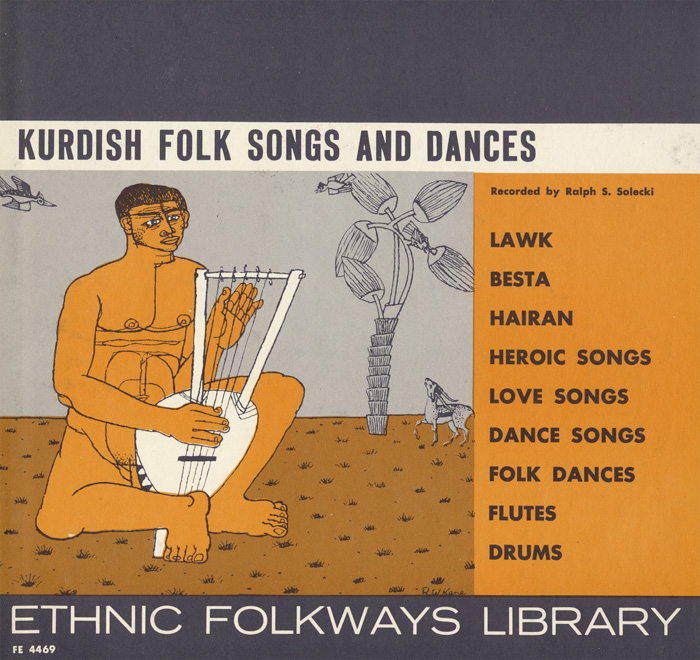
“Besta”
from Kurdish Folk Songs and Dances (1955) | FW04469
Procedure:
1. Continuing “a day in the life of a Kurdish kid,” tell the children that once all the work is done children have time to have fun, which they do by dancing.
2. Explain that Kurdish folk dances are most often done in a straight line, with everyone dancing the same steps all together. Demonstrate with other teachers. (Stand in straight line. March in place together. Bounce together. Hop together. The children will love to see their teachers dance.)
3. Ask children what sounds they make or what words they say when they're really happy. (You may prompt them by starting with, “YAY!” or “WOO-HOO!” or “WHEE!”) Let them know that Kurdish singers, when they're really happy, make the sound, “Lu lu lu lu lu lu lu lu!!” (Make the sound high, loud, fast and with joy!) Have the children imitate the sound. [You can hear an example at 2:04 into the song, “Besta” found on “Kurdish Folk Songs and Dances”. If you don't own the track and are not familiar with the sound, approximate with gusto.]
4. Tell the children that when they hear “lu lu lu lu lu!,” that's their cue to get up as fast as they can, stand in a straight line and get ready to dance. Test them on this by singing, “lu lu lu lu lu!” and see how fast they can get into a straight line. The first time help them form a line. Then, have them do this a number of times, challenging them to get into their places faster and faster.
5. Once they've mastered that, tell the children they're going to do a dance that's a form of the game “freeze,” and that they have to watch you very closely. Not only will they have to imitate what you do (if you clap, they should clap), but whenever you sing, “Look in my eyes!” they have to freeze and not start moving again until you tell them what the next motion will be. Start the song, “Look in My Eyes” (notated below) by clapping: 1 2 3 4, 1 2 3 4. Sing the melody on “lai;” go through the song enough times for them to start singing, then when you're ready, sing “Look in my eyes!” and stop clapping. Open your eyes wide and look at the kids, trying to make them laugh while they're freezing. When you're ready, lead them on to the next movement, picking up the direction;for example, “march in place!”--in the measure before the melody starts again. Enjoy the song as long as the children are having fun. (Practice beforehand so you not only know the right timing for your instructions but also have a list in your mind of things to have the children do: hop on one foot! Everybody bounce! Dance dance dance!) [“Look in My Eyes” is an adaptation of a song called “Besta” found on “Kurdish Folk Songs and Dances”. You will listen to “Besta” in Lesson Segment 6.]

Extension:
- From this point forth throughout the school year, whenever you sing, “lu lu lu lu lu!” the children should line up and be ready to dance. Try it at unexpected times.
Assessment:
- Do the children understand the idea that most Kurdish public folk dances are line dances which dancers do in unison?
Lesson Segment #4. “Sing To Me, Mamiana”
Procedure:
1. When the children calm down from dancing, have them sit on the floor in a circle. Let them know that, in their “day” as a Kurdish child, the next thing to do is spend some quiet time with their family, and/or “the people you love.” You may ask them who they love: mom? Dad? Grandma? Their cow?
2. Tell them that many, many Kurdish folks songs are love songs. (This is an especially important lesson in a time when Kurds and others from West Asia/the Middle East often appear in the media in association with violence.)
3. Say to the children that there once was a wonderful girl named Mamiana and that a boy loved her so much he wrote her a song. Have the children sway side to side two beats on each side (left left, right right) to fit the rhythm of the song, “Mamiana.” (Notated below.) Sing through the song once with swaying, then repeat with bouncing, wiggling, shaking, making swimming motions, lifting arms up and down, etc. Encourage the children to sing along. End the song by repeating the melody accompanied by swaying. [“Mamiana” is an adaptation of the first part of the track “Love Songs” found on “Kurdish Folk Songs and Dances”. You will listen to “Love Songs” in lesson segment #6.]

Extension:
- You may repeat the same love song at any time you in the future you and your class are singing, using the name Mamiana, replacing it with the names of the children (“Lily, sing to me-ee-ee-ee Lily”) or replacing it with the name of someone a child said s/he loves (“Addy's doggie, sing to me-ee Addy's doggie.”)
Assessment:
- Do the children appreciate the concept that many traditional Kurdish folk songs are love songs?
Lesson Segment #5. “Good Night, Kurdistan!”
Procedure:
1. Finally, after a long day working on the farm, tell the children the time has come to for bed. Have them pretend they're going to sleep.
2. When the children are calm and the class is silent, tell the children that in Kurdish music, when a singer wants to sing “la la la” s/he will likely sing, “lai lai lai.” Ask the children to repeat “lai lai lai.”
3. Start the song, “Lai Lai Lai,” notated below, singing the melody to “lai lai lai.” Encourage the children to sing along. Repeat calmly, many times. [“Lai Lai Lai” is an adaptation of “Lailai” from Kurdish Folk Music from Iran. You will listen to “Lailai” in lesson segment #6.]
- When the children are especially quiet, sing “Lai Lai Lai” using each child's name in turn: “Molly's sleeping, lai lai lai, lai lai lai, lai lai lai.” Don't forget the other teachers and yourself--“Mr. Jay is sleeping, lai lai lai, lai lai lai lai lai lai.” Finish with, “We're all sleeping, lai lai lai, lai lai lai, lai lai lai.” End with several seconds of silence. Then, sing, “LU LU LU LU LU!” Watch the kids leap up, jump into the line and get ready to dance.

Extension:
- Repeat “Lai Lai Lai” throughout the school year whenever you want to calm down the class.
Assessment:
- At the end of the school day, ask the class to tell you what they learned about a day in the life of a Kurdish child who lives on a farm. Reinforce the concepts that some Kurdish songs are work songs, many others are love songs, and that most folk dancing happens in a line with motions done together.
Lesson Segment #6. “The Oud Dude”
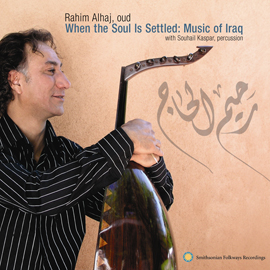
“Taqsim Maqam Kurd”
from When the Soul is Settled: Music of Iraq (2006) | SFW40533
Procedure:
1. This segment should take place after the first five segments, either after a lunch on the same day or the following day. The time has come to introduce Kurds singing the songs the children already know from the earlier lessons.
2. Be ready to listen to the following tracks:
- “Gawas: Manga Lawaneh” and “Lailai” from “Kurdish Folk Music from Western Iran”
- “Love Songs” and “Besta” from “Kurdish Folk Songs and Dances”. When you listen to each track, have the children to listen through once, then ask them which song they know matches the track. You may need to prompt them at first, but the children should recognize the songs they now know how to sing. Some of the children may start milking cows when they hear, “Gawas,” pretend to sleep when they recognize “Lailai,” sway to “Mamiana” and even hop out of their seats and dance to “Besta” (which you should encourage!). Listen to each track with them again, singing the words they know along with the original recording. Reinforce the lessons from the other segments: “This is a love song.” “This is a song about work.” In “Gawas,” ask the children what they hear beyond the singing. (It's a rooster!) Listening to “Lailai,” have the children imagine a Kurdish mother putting her baby to sleep. During “Besta,” if you own the track and can listen to all four minutes, have the children dance to the original. You may add a bit of interest by clapping along with the hand claps on the CD, seeing if the children can match you. Give the children high praise. They now know an entire repertoire of Kurdish folk songs!
- Once the class has finished dancing “Besta,” note that while the original versions of the songs they heard didn't contain instrumentation beyond hand clapping, Kurdish folk music does often feature instruments. The liner notes of “Kurdish Folk Music from Western Iran” provides a section about Kurdish musical instruments. Put the name of each into the image search of any internet search engine to show the class a picture. Listen through “Kurdish Folk Muisc from Western Iran” and “Kurdish Folk Songs and Dances” for examples of Kurdish songs with instrumentation. If you think your children are up to it, try to match the instruments with the recordings. (Print pictures of each instrument, tape them to the wall and have the children point to the instrument/s they think they hear in each song.)
3. Explain to the children that two instruments are particularly popular around West Asia and the Middle East - the oud, which an ancient lute/guitar (an image of a woman paying a lute first a appeared on a clay table over five thousand years ago), and the doumbek, a drum shaped like a goblet that has various names in different parts of the region. Though rural Kurdish music relied more on vocals than instrumentation, and rarely if ever featured the oud, today musicians from throughout the region readily use the oud when performing Kurdish music.
4. Listen to “Taqsim Maqam Kurd” from Rahim Alhaj's “When the Soul is Settled: Music of Iraq”. Ask children how they think someone plays an oud and have them pretend to do it. (“Air oud.”) You may tell them they're listening common set of notes found in Kurdish music, though in part because Kurds live in many nations, there are many divergent variations on the theme. This reinforces the concept in lesson segment #1.
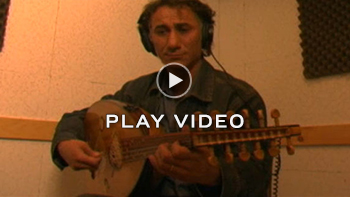
Video: Video: Rahim Alhaj featuring Souhail Kaspar "Rast" Studio Session May 5, 2005 Smithsonian Folkways Recordings
5. Watch video of Rahim Alhaj and Soulhail Kaspar. Ask which is the doumbek and which is the oud. Have the children imitate their favorite of the two instruments. You may even have the children break up into two groups, one that prefers the oud and another that prefers the doumbek, and pretend they're playing the song as you watch the video again. After the video has run its course, sing “LU LU LU LU LU!” and have the children dance “Look In My Eyes.”
Extension:
- Play CD tracks as children are entering the classroom in the morning or between activities. Make “When the Soul is Settled” a musical staple in your classroom.
Assessment:
- Do the children know the oud is like a guitar and the doumbek is a hand drum? Are they eager to learn more about West Asian/Middle Eastern music? Are you?


